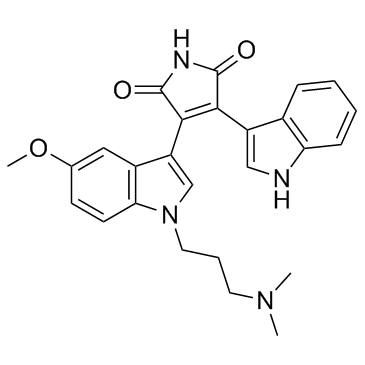Zeta Inhibitory Peptide Disrupts Electrostatic Interactions That Maintain Atypical Protein Kinase C in Its Active Conformation on the Scaffold p62.
Li-Chun Lisa Tsai, Lei Xie, Kim Dore, Li Xie, Jason C Del Rio, Charles C King, Guillermo Martinez-Ariza, Christopher Hulme, Roberto Malinow, Philip E Bourne, Alexandra C Newton
Index: J. Biol. Chem. 290 , 21845-56, (2015)
Full Text: HTML
Abstract
Atypical protein kinase C (aPKC) enzymes signal on protein scaffolds, yet how they are maintained in an active conformation on scaffolds is unclear. A myristoylated peptide based on the autoinhibitory pseudosubstrate fragment of the atypical PKCζ, zeta inhibitory peptide (ZIP), has been extensively used to inhibit aPKC activity; however, we have previously shown that ZIP does not inhibit the catalytic activity of aPKC isozymes in cells (Wu-Zhang, A. X., Schramm, C. L., Nabavi, S., Malinow, R., and Newton, A. C. (2012) J. Biol. Chem. 287, 12879-12885). Here we sought to identify a bona fide target of ZIP and, in so doing, unveiled a novel mechanism by which aPKCs are maintained in an active conformation on a protein scaffold. Specifically, we used protein-protein interaction network analysis, structural modeling, and protein-protein docking to predict that ZIP binds an acidic surface on the Phox and Bem1 (PB1) domain of p62, an interaction validated by peptide array analysis. Using a genetically encoded reporter for PKC activity fused to the p62 scaffold, we show that ZIP inhibits the activity of wild-type aPKC, but not a construct lacking the pseudosubstrate. These data support a model in which the pseudosubstrate of aPKCs is tethered to the acidic surface on p62, locking aPKC in an open, signaling-competent conformation. ZIP competes for binding to the acidic surface, resulting in displacement of the pseudosubstrate of aPKC and re-engagement in the substrate-binding cavity. This study not only identifies a cellular target for ZIP, but also unveils a novel mechanism by which scaffolded aPKC is maintained in an active conformation. © 2015 by The American Society for Biochemistry and Molecular Biology, Inc.
Related Compounds
| Structure | Name/CAS No. | Molecular Formula | Articles |
|---|---|---|---|
 |
Go 6983
CAS:133053-19-7 |
C26H26N4O3 |
|
HSPB1 as a novel regulator of ferroptotic cancer cell death.
2015-11-05 [Oncogene 34(45) , 5617-25, (2015)] |
|
High-throughput protease activity cytometry reveals dose-dep...
2015-05-01 [Integr. Biol. (Camb.) 7 , 513-24, (2015)] |
|
Downregulation of vimentin in macrophages infected with live...
2016-01-01 [Sci. Rep. 6 , 21526, (2016)] |
|
Effects of Hydrostatic Pressure on Carcinogenic Properties o...
2015-01-01 [PLoS ONE 10 , e0145522, (2015)] |
|
Phosphorylation of VACM-1/Cul5 by protein kinase A regulates...
2010-02-12 [J. Thorac. Cardiovasc. Surg. 285 , 4883-95, (2010)] |